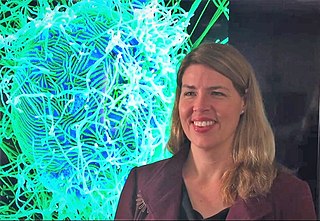Related Research Articles

A single-domain antibody (sdAb), also known as a Nanobody, is an antibody fragment consisting of a single monomeric variable antibody domain. Like a whole antibody, it is able to bind selectively to a specific antigen. With a molecular weight of only 12–15 kDa, single-domain antibodies are much smaller than common antibodies which are composed of two heavy protein chains and two light chains, and even smaller than Fab fragments and single-chain variable fragments.
An ectodomain is the domain of a membrane protein that extends into the extracellular space. Ectodomains are usually the parts of proteins that initiate contact with surfaces, which leads to signal transduction. A notable example of an ectodomain is the S protein, commonly known as the spike protein, of the viral particle responsible for the COVID-19 pandemic. The ectodomain region of the spike protein (S) is essential for attachment and eventual entry of the viral protein into the host cell.

The Vaccine Research Center (VRC), is an intramural division of the National Institute of Allergy and Infectious Diseases (NIAID), part of the National Institutes of Health (NIH), US Department of Health and Human Services (HHS). The mission of the VRC is to discover and develop both vaccines and antibody-based products that target infectious diseases.
A heavy-chain antibody is an antibody which consists only of two heavy chains and lacks the two light chains usually found in antibodies.

Erica Ollmann Saphire is an American structural biologist and immunologist and a professor at the La Jolla Institute for Immunology. Her research investigates the structural biology of viruses that cause hemorrhagic fever such as Ebola, Sudan, Marburg, Bundibugyo, and Lassa. She was awarded the Presidential Early Career Award for Scientists and Engineers in 2008.

Coronavirus disease 2019 (COVID-19) is a contagious disease caused by the virus SARS-CoV-2. The first known case was identified in Wuhan, China, in December 2019. The disease quickly spread worldwide, resulting in the COVID-19 pandemic.

COVID-19 testing involves analyzing samples to assess the current or past presence of SARS-CoV-2. The two main types of tests detect either the presence of the virus or antibodies produced in response to infection. Molecular tests for viral presence through its molecular components are used to diagnose individual cases and to allow public health authorities to trace and contain outbreaks. Antibody tests instead show whether someone once had the disease. They are less useful for diagnosing current infections because antibodies may not develop for weeks after infection. It is used to assess disease prevalence, which aids the estimation of the infection fatality rate.

COVID-19 drug development is the research process to develop preventative therapeutic prescription drugs that would alleviate the severity of coronavirus disease 2019 (COVID-19). From early 2020 through 2021, several hundred drug companies, biotechnology firms, university research groups, and health organizations were developing therapeutic candidates for COVID-19 disease in various stages of preclinical or clinical research, with 419 potential COVID-19 drugs in clinical trials, as of April 2021.

Kizzmekia "Kizzy" Shanta Corbett is an American viral immunologist. She is an Assistant Professor of Immunology and Infectious Diseases at Harvard T.H. Chan School of Public Health and the Shutzer Assistant Professor at the Harvard Radcliffe Institute since June 2021.
Susan R. Weiss is an American microbiologist who is a Professor of Microbiology at the Perelman School of Medicine at the University of Pennsylvania. She holds vice chair positions for the Department of Microbiology and for Faculty Development. Her research considers the biology of coronaviruses, including SARS, MERS and SARS-CoV-2. As of March 2020, Weiss serves as Co-Director of the University of Pennsylvania/Penn Medicine Center for Research on Coronavirus and Other Emerging Pathogens.
Jason S. McLellan is a structural biologist, professor in the Department of Molecular Biosciences and Robert A. Welch Chair in Chemistry at The University of Texas at Austin who specializes in understanding the structure and function of viral proteins, including those of coronaviruses. His research focuses on applying structural information to the rational design of vaccines and other therapies for viruses, including SARS-CoV-2, the novel coronavirus that causes COVID-19, and respiratory syncytial virus (RSV). McLellan and his team collaborated with researchers at the National Institute of Allergy and Infectious Diseases’ Vaccine Research Center to design a stabilized version of the SARS-CoV-2 spike protein, which biotechnology company Moderna used as the basis for the vaccine mRNA-1273, the first COVID-19 vaccine candidate to enter phase I clinical trials in the U.S. At least three other vaccines use this modified spike protein: those from Pfizer and BioNTech; Johnson & Johnson and Janssen Pharmaceuticals; and Novavax.

The COVID-19 pandemic has affected animals directly and indirectly. SARS-CoV-2, the virus that causes COVID-19, is zoonotic, which likely to have originated from animals such as bats and pangolins. Human impact on wildlife and animal habitats may be causing such spillover events to become much more likely. The largest incident to date was the culling of 14 to 17 million mink in Denmark after it was discovered that they were infected with a mutant strain of the virus.
Bamlanivimab is a monoclonal antibody developed by AbCellera Biologics and Eli Lilly as a treatment for COVID-19. The medication was granted an emergency use authorization (EUA) by the US Food and Drug Administration (FDA) in November 2020, and the EUA was revoked in April 2021.

EpiVacCorona is a peptide-based vaccine against COVID-19 developed by the Russian VECTOR Center of Virology. The lack of protective effectiveness of EpiVacCorona, which is still in use in Russia, has been reported in scientific literature and in the media. The vaccine consists of three chemically synthesized peptides that are conjugated to a large carrier protein. This protein is a fusion product of a viral nucleocapsid protein and a bacterial MBP protein. A phase III clinical trial to show whether or not the vaccine can protect people against COVID-19 was launched in November 2020 with more than three thousand participants. The conclusions and results of the trial have not been made public.
Bamlanivimab/etesevimab is a combination of two monoclonal antibodies, bamlanivimab and etesevimab, administered together via intravenous infusion as a treatment for COVID-19. Both types of antibody target the surface spike protein of SARS‑CoV‑2.

Alex Sigal is a South Africa–based virologist at the Africa Health Research Institute (AHRI) in Durban, South Africa, Max Planck Institute for Infection Biology in Berlin, and University of KwaZulu-Natal in Durban. His work concentrates on evolution and persistence of the SARS-CoV-2 virus. His laboratory was the first to isolate the live B.1.351 (Beta) variant of SARS-CoV-2 first detected in South Africa. Sigal’s laboratory was also the first to report results on the ability of the Omicron variant to escape antibody neutralization in individuals who had two doses of the Pfizer BNT162b2 vaccine as well as from previous infections, with results also suggesting that vaccination combined with a booster or previous infection can offer protection from symptomatic infection with Omicron.

Spike (S) glycoprotein is the largest of the four major structural proteins found in coronaviruses. The spike protein assembles into trimers that form large structures, called spikes or peplomers, that project from the surface of the virion. The distinctive appearance of these spikes when visualized using negative stain transmission electron microscopy, "recalling the solar corona", gives the virus family its main name.
William Paul Duprex is a British scientist and advocate for vaccines and global health. He serves as Director of the University of Pittsburgh's Center for Vaccine Research and Regional Biocontainment Laboratory. Duprex holds the Jonas Salk Chair in Vaccine Research. He is also a professor of microbiology and molecular genetics at the University of Pittsburgh School of Medicine and serves as Editor-in-Chief of the Journal of General Virology, which is published by the Microbiology Society, and a senior editor of mSphere, published by the American Society for Microbiology. Duprex is an expert in measles and mumps viruses and studies viral spillover from animals to humans, including the SARS-CoV-2 virus that caused the COVID-19 pandemic. Duprex is a Fellow of the American Academy of Microbiology.
Bebtelovimab is a monoclonal antibody developed by AbCellera and Eli Lilly as a treatment for COVID-19.
References
- 1 2 3 Swenson, Haylie (December 2020). "2020 Golden Goose Award: A Llama Named Winter". American Association for the Advancement of Science . Retrieved 23 March 2023.
- 1 2 Andre Salle's (9 March 2021). "Why the lovable llama might be a secret weapon against COVID-19". Argonne National Laboratory.
- ↑ Kramer, Jillian (6 May 2020). "Hoping Llamas Will Become Coronavirus Heroes". The New York Times– via NYTimes.com.
- ↑ Vanmecheln, Kurt. "Winter's Kilobytes × we (Wk×W) | LABIOMISTA". www.labiomista.be. Retrieved 18 November 2021.